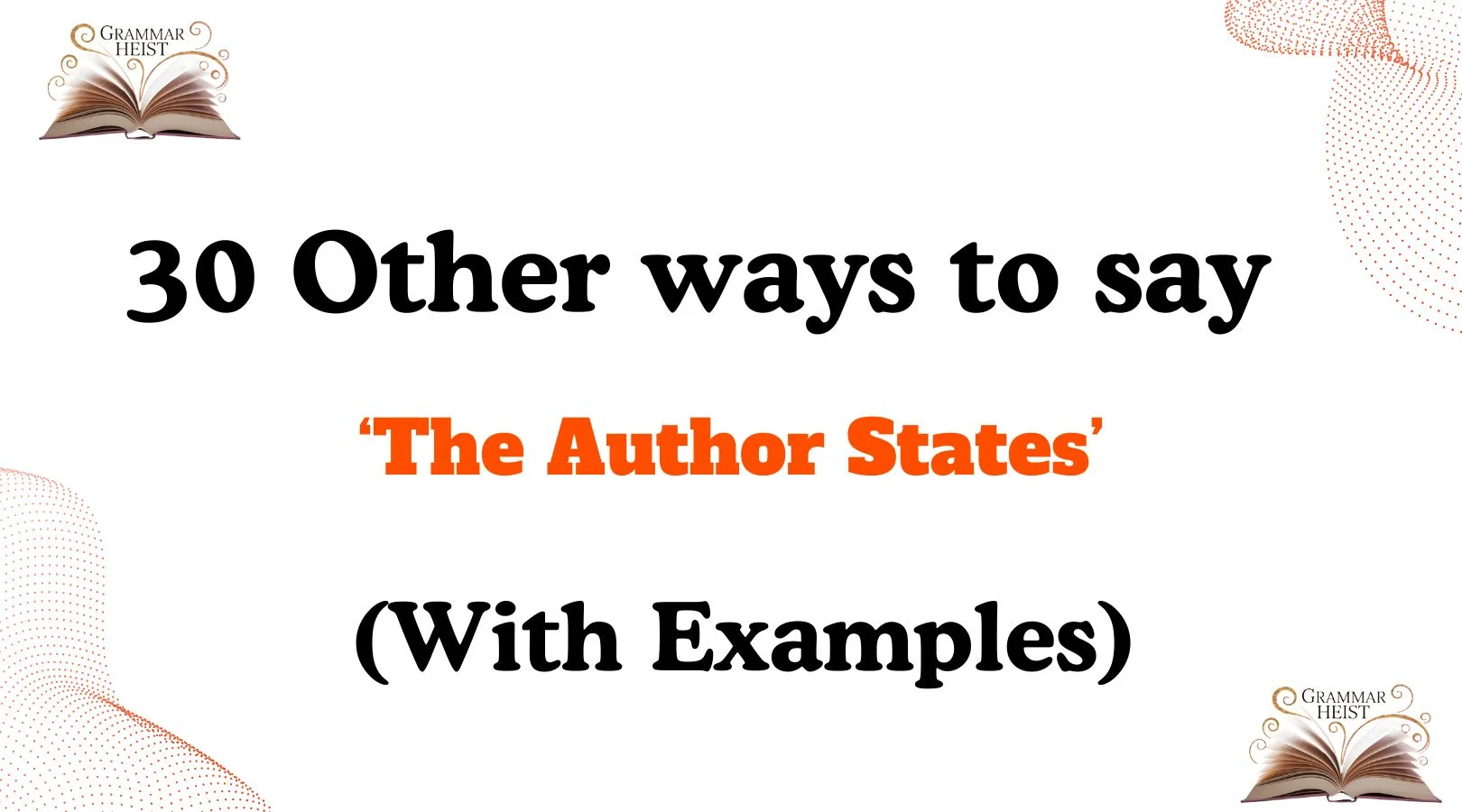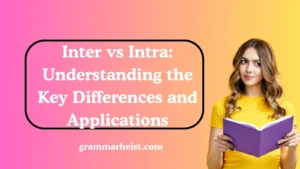Finding the right words when writing or analyzing someone else’s work can make your communication not only clearer but also more engaging and thoughtful. Instead of using the same phrase repeatedly, like “the author states,” exploring alternative expressions helps your writing sound more natural, warm, and polished.
Below, you’ll find 30 meaningful alternatives, along with scenarios, examples, tone, and explanations to guide you in using them effectively.
What Does “The Author States” Mean?
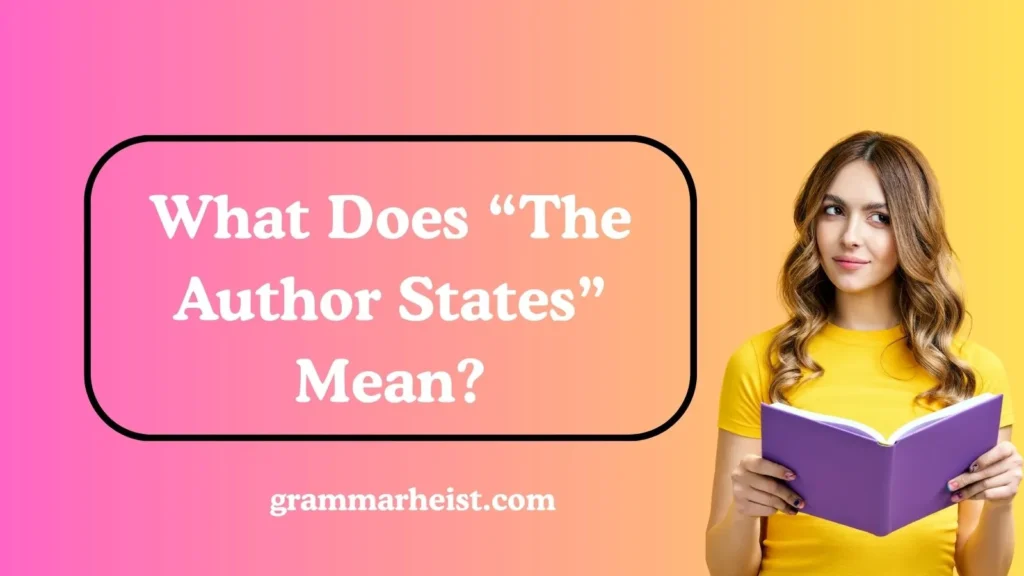
The phrase “the author states” is commonly used in academic or professional writing to indicate that the writer is referencing or summarizing what another author has expressed in their work. It signals attribution, ensuring credit is given to the source.
Is It Professional/Polite to Say “The Author States”?
Yes, it is professional and polite, but it can also feel a little formal or repetitive if overused. For smoother and more engaging writing, mixing in alternatives keeps your tone more dynamic and thoughtful.
Pros or Cons of Saying “The Author States”
Pros
- Professional and direct
- Clearly attributes information to the source
- Widely accepted in academic and workplace writing
Cons
- Can feel repetitive and stiff
- May lack warmth or variety
- Sometimes too formal for conversational writing
short Summary
Varying phrasing in academic writing keeps ideas engaging and precise. Depending too much on one expression—like “the author states”—can make writing dull, so exploring alternatives improves clarity and style. With practice, you’ve learned and taught others that there are many effective ways to express the same idea without losing meaning. Choosing the right phrasing enhances flow, strengthens communication, and makes writing feel more thoughtful and polished.
Synonyms For “The Author States”
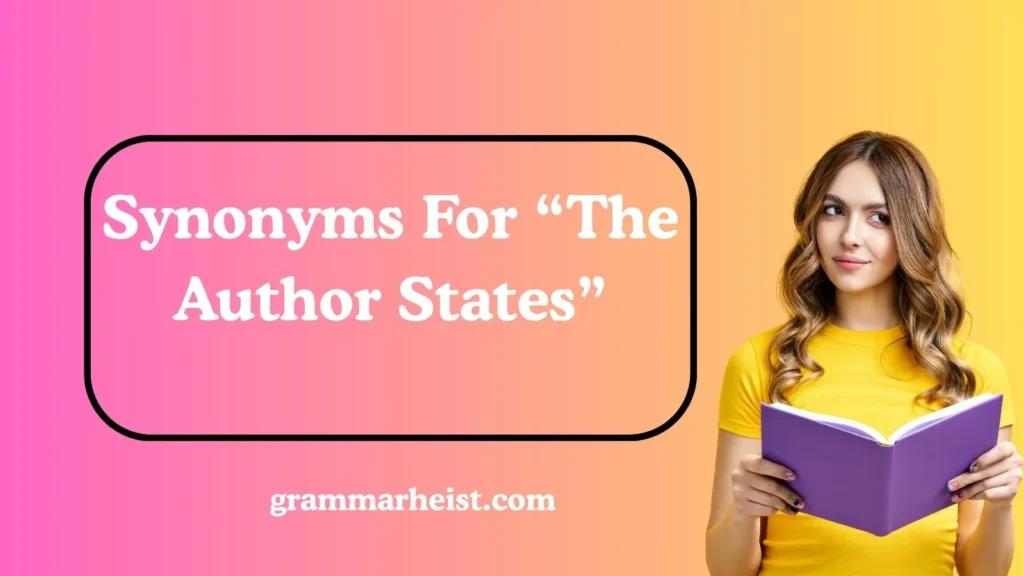
- The Author Notes
- The Author Mentions
- The Author Writes
- The Author Explains
- The Author Observes
- The Author Highlights
- The Author Argues
- The Author Suggests
- The Author Points Out
- The Author Remarks
- The Author Emphasizes
- The Author Asserts
- The Author Declares
- The Author Proposes
- The Author Expresses
- The Author Comments
- The Author Concludes
- The Author Suggests That
- The Author Reveals
- The Author Outlines
- The Author Indicates
- The Author Demonstrates
- The Author Affirms
- The Author Reflects
- The Author Reports
- The Author Chronicles
- The Author Conveys
- The Author Stresses
- The Author Implies
- The Author Insists
1. The Author Notes
Scenario: When summarizing a point made by the author in a calm, reflective way.
Examples:
- The author notes that leadership styles greatly influence workplace morale.
- In her study, the author notes a shift in cultural perceptions.
- The author notes the significance of continuous learning in professional growth.
Tone: Reflective, thoughtful, and slightly formal.
Explanation: Best used when highlighting observations or insights. Softer than “states,” it suggests the author made a careful remark rather than a firm declaration.
2. The Author Mentions
Scenario: Useful when the author briefly includes an idea without making it central.
Examples:
- The author mentions teamwork as a key factor in success.
- In the introduction, the author mentions various perspectives.
- The author mentions that small changes can lead to major results.
Tone: Conversational, lighter, and less formal.
Explanation: This works when you want to acknowledge the author’s idea without giving it heavy weight. It keeps your writing approachable and friendly.
3. The Author Writes
Scenario: Ideal for directly pointing to the text itself.
Examples:
- The author writes that persistence is the foundation of progress.
- As the author writes, innovation drives growth.
- The author writes about balancing professional and personal life.
Tone: Clear, direct, and neutral.
Explanation: This phrase emphasizes the act of writing. It’s straightforward and professional but still softer than “states.”
4. The Author Explains
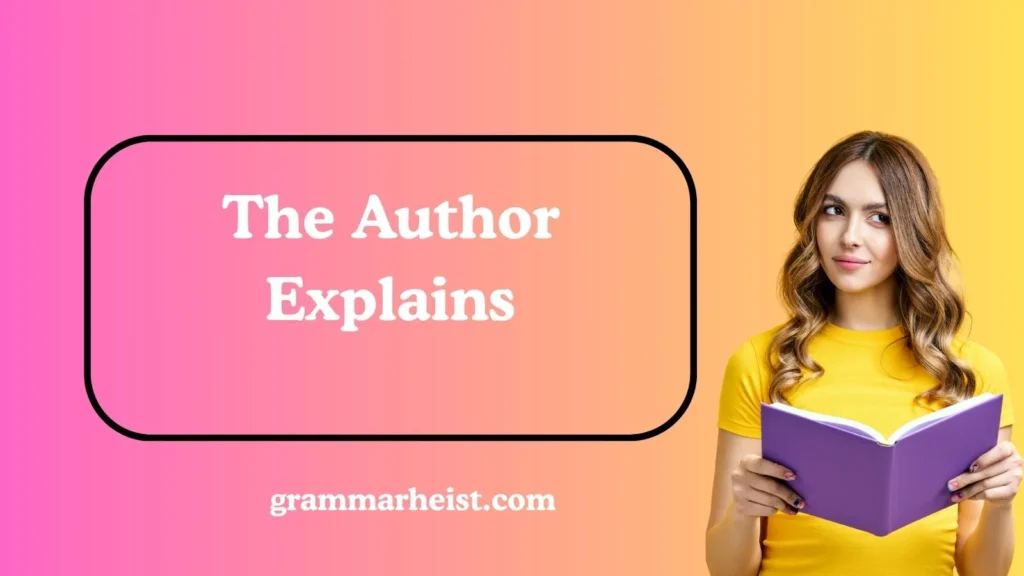
Scenario: Best for moments when the author is clarifying, justifying, or unpacking ideas.
Examples:
- The author explains that trust is the cornerstone of healthy teams.
- The author explains how habits shape long-term results.
- The author explains the reasoning behind her argument.
Tone: Instructional, guiding, and thoughtful.
Explanation: This alternative adds a sense of teaching or clarification, making it excellent for contexts where the author is breaking down complex information.
5. The Author Observes
Scenario: Best when the author is pointing out a detail, trend, or insight based on careful consideration.
Examples:
- The author observes that remote work has changed collaboration styles.
- The author observes shifts in how younger generations view leadership.
- The author observes that creativity thrives in flexible environments.
Tone: Analytical, reflective, and observational.
Explanation: This choice highlights that the author is paying attention to patterns rather than making bold claims. It softens the statement and shows attentiveness.
6. The Author Highlights
Scenario: Effective when the author draws special attention to something important.
Examples:
- The author highlights the role of empathy in leadership.
- In her paper, the author highlights the challenges of digital learning.
- The author highlights several solutions to reduce workplace burnout.
Tone: Emphatic, focused, and engaging.
Explanation: This alternative signals importance. Use it when the author is emphasizing a point that deserves extra notice from the reader.
7. The Author Argues
Scenario: Useful when the author is taking a clear stance or defending a viewpoint.
Examples:
- The author argues that diversity strengthens decision-making.
- The author argues against the use of outdated management methods.
- The author argues for more investment in mental health initiatives.
Tone: Assertive, persuasive, and formal.
Explanation: This phrase fits academic or professional writing when the author is strongly presenting or defending a claim. It carries more weight than “states.”
8. The Author Suggests
Scenario: Best when the author is offering a recommendation or possibility, not a firm conclusion.
Examples:
- The author suggests rethinking how success is measured.
- The author suggests that collaboration fosters innovation.
- The author suggests alternative approaches to traditional leadership.
Tone: Gentle, guiding, and open-ended.
Explanation: This works well when you want to present the author’s idea without making it sound absolute. It implies openness and consideration.
9. The Author Points Out
Scenario: Good for drawing attention to something noticeable or significant.
Examples:
- The author points out the rise of remote-first companies.
- The author points out that communication gaps harm efficiency.
- The author points out the value of lifelong learning.
Tone: Neutral, straightforward, slightly conversational.
Explanation: This phrase makes the text accessible and easy to follow. It shows the author is directing the reader’s attention to something specific.
10. The Author Remarks
Scenario: Suitable when the author makes a thoughtful or passing comment.
Examples:
- The author remarks that balance is key to long-term success.
- The author remarks on the similarities between old and new methods.
- The author remarks that trends often repeat themselves.
Tone: Reflective, slightly conversational, softer than “states.”
Explanation: This option adds nuance. It makes the author’s words feel less forceful and more like an observation worth noting.
11. The Author Emphasizes
Scenario: Best when the author is strongly underlining an idea or theme.
Examples:
- The author emphasizes the importance of transparency in leadership.
- The author emphasizes the role of active listening in communication.
- The author emphasizes that growth comes from consistent effort.
Tone: Strong, focused, and deliberate.
Explanation: Use this when the author is highlighting something as crucial. It signals weight and seriousness.
12. The Author Asserts
Scenario: Works when the author presents something as fact or with firm conviction.
Examples:
- The author asserts that equality benefits all levels of an organization.
- The author asserts the importance of adapting to technological change.
- The author asserts that leaders must lead by example.
Tone: Confident, formal, and firm.
Explanation: “Asserts” has a strong academic and professional feel. It indicates certainty, making it ideal for authoritative claims.
13. The Author Declares
Scenario: Suitable when the author makes a bold or official statement.
Examples:
- The author declares that creativity is the future of problem-solving.
- The author declares a need for systemic change in policy-making.
- The author declares that resilience defines successful leaders.
Tone: Bold, assertive, and powerful.
Explanation: This alternative is dramatic and strong. Use sparingly to convey the author’s confidence or passion.
14. The Author Proposes
Scenario: Best for when the author is offering an idea, solution, or course of action.
Examples:
- The author proposes new methods to reduce employee burnout.
- The author proposes a framework for sustainable innovation.
- The author proposes collaboration across departments to solve challenges.
Tone: Constructive, solution-oriented, and professional.
Explanation: “Proposes” shows the author is putting forward an idea, often for consideration or further discussion.
15. The Author Expresses
Scenario: Works when the author shares feelings, perspectives, or opinions.
Examples:
- The author expresses concern about the lack of inclusivity in workplaces.
- The author expresses optimism for the future of digital learning.
- The author expresses doubt about outdated management models.
Tone: Emotional, empathetic, and expressive.
Explanation: This alternative highlights the emotional or personal side of the author’s words, not just factual content.
16. The Author Comments
Scenario: Good when the author is providing a side note or reflective thought.
Examples:
- The author comments on the rise of hybrid work models.
- The author comments that flexibility fosters loyalty.
- The author comments on the challenges faced by young leaders.
Tone: Light, conversational, reflective.
Explanation: This phrase softens the author’s contribution, making it feel like an observation rather than a strong claim.
17. The Author Concludes
Scenario: Ideal for end-of-section summaries or final thoughts.
Examples:
- The author concludes that adaptability is key to success.
- The author concludes by highlighting the importance of innovation.
- The author concludes that leadership requires humility.
Tone: Final, decisive, and structured.
Explanation: This phrase signals closure. It shows the author has reached a resolution or drawn together their main points.
18. The Author Suggests That
Scenario: Works when the author recommends or implies an idea indirectly.
Examples:
- The author suggests that change begins with mindset shifts.
- The author suggests that collaboration improves creativity.
- The author suggests that ongoing education enhances professional growth.
Tone: Gentle, guiding, and respectful.
Explanation: Adding “that” makes it feel more natural in written flow. It also softens the statement, keeping it approachable.
19. The Author Reveals
Scenario: Best when the author is presenting new findings, discoveries, or insights.
Examples:
- The author reveals surprising statistics about consumer behavior.
- The author reveals hidden patterns in workplace communication.
- The author reveals the key to sustaining motivation.
Tone: Intriguing, insightful, sometimes dramatic.
Explanation: This alternative adds a sense of discovery, drawing the reader’s attention to something previously unknown.
20. The Author Outlines
Scenario: Effective when the author is presenting structure, steps, or a plan.
Examples:
- The author outlines a five-step approach to leadership.
- The author outlines the history of communication in workplaces.
- The author outlines strategies for building inclusive cultures.
Tone: Clear, organized, and methodical.
Explanation: This phrase suggests structure and clarity. Use it when the author is providing a roadmap or framework.
Read More:30 Other Ways to Say ‘Get Well Soon’ (With Examples)
21. The Author Indicates
Scenario: Useful when the author points indirectly to evidence or makes a subtle suggestion.
Examples:
- The author indicates that motivation increases with recognition.
- The author indicates a trend toward flexible scheduling.
- The author indicates the importance of cultural awareness in teams.
Tone: Neutral, formal, and understated.
Explanation: This phrase works well when the author isn’t forceful but still signals a direction or meaning.
22. The Author Demonstrates
Scenario: Best when the author shows proof through data, examples, or case studies.
Examples:
- The author demonstrates how habits shape behavior over time.
- The author demonstrates the link between trust and performance.
- The author demonstrates that innovation thrives in diverse teams.
Tone: Evidence-based, formal, and authoritative.
Explanation: Stronger than “notes” or “mentions,” this phrase highlights that the author is providing clear proof.
23. The Author Affirms
Scenario: Works when the author confirms or validates a point with certainty.
Examples:
- The author affirms the value of ethical leadership.
- The author affirms that communication is key to team unity.
- The author affirms long-term growth requires adaptability.
Tone: Confident, positive, and supportive.
Explanation: Use when the author is reinforcing or validating a statement, showing alignment with a strong idea.
24. The Author Reflects
Scenario: Suitable when the author is looking back thoughtfully on experiences or insights.
Examples:
- The author reflects on the evolution of workplace culture.
- The author reflects on lessons learned through failure.
- The author reflects on how leadership styles have shifted over time.
Tone: Thoughtful, introspective, and personal.
Explanation: This choice conveys depth, often linked to experience and self-awareness, adding warmth to the writing.
25. The Author Reports
Scenario: Good for summarizing research, findings, or factual updates.
Examples:
- The author reports a rise in hybrid work adoption.
- The author reports challenges faced by new entrepreneurs.
- The author reports positive outcomes from mentoring programs.
Tone: Objective, factual, and professional.
Explanation: Neutral and clear, “reports” is especially common in research or journalism.
26. The Author Chronicles
Scenario: Best when the author provides a detailed account or historical overview.
Examples:
- The author chronicles the evolution of digital marketing.
- The author chronicles leadership approaches across centuries.
- The author chronicles changes in workplace norms.
Tone: Historical, descriptive, and narrative.
Explanation: This choice emphasizes storytelling and sequence, useful for history or detailed journeys.
27. The Author Conveys
Scenario: Works when the author communicates feelings, themes, or perspectives.
Examples:
- The author conveys optimism about the future of education.
- The author conveys urgency in addressing climate change.
- The author conveys the challenges of maintaining work-life balance.
Tone: Expressive, thoughtful, and empathetic.
Explanation: Softer than “states,” this phrase suggests the author is communicating meaningfully, not just factually.
28. The Author Stresses
Scenario: Best when the author strongly insists on the importance of an idea.
Examples:
- The author stresses the need for consistent communication.
- The author stresses the urgency of addressing employee burnout.
- The author stresses that adaptability is essential in changing times.
Tone: Forceful, serious, and deliberate.
Explanation: This phrase is similar to “emphasizes” but carries even more urgency, showing importance.
29. The Author Implies
Scenario: Suitable when the author hints at something indirectly rather than stating it outright.
Examples:
- The author implies that leadership begins with self-awareness.
- The author implies a shift in societal values is underway.
- The author implies that growth requires discomfort.
Tone: Subtle, suggestive, and interpretive.
Explanation: “Implies” signals that the meaning is not directly stated but can be inferred, encouraging deeper thought.
30. The Author Insists
Scenario: Effective when the author is standing firm and not yielding on a point.
Examples:
- The author insists that integrity should guide decision-making.
- The author insists on the value of collaboration in innovation.
- The author insists that leaders must remain accountable.
Tone: Strong, authoritative, and unwavering.
Explanation: This alternative is powerful and confident, used when the author’s stance is clear and non-negotiable.
FAQs:
1. What does “the author states” mean in academic writing?
It’s a common phrase used to show what an author has written or expressed in a text.
2. Why should I avoid repeating “the author states”?
Repetition makes writing sound dull and reduces clarity. Using alternatives improves flow and engagement.
3. What are some alternatives to “the author states”?
Phrases like the author explains, the writer argues, the text suggests, or the author highlights work well.
4. How do I choose the best alternative phrase?
Pick a phrase that matches the author’s action. For example, use “argues” for opinions and “explains” for clarifications.
5. Will using varied phrases improve my academic writing?
Yes, it enriches tone, increases readability, and shows a stronger command of language.
6. Can varying phrasing change the meaning of a sentence?
It can if used incorrectly. Choose alternatives that accurately represent the author’s intent.
7. How many alternatives should I use in an essay?
Use as many as needed, but keep them accurate and context-appropriate. Balance variety with clarity.
8. Are these alternatives suitable for casual writing too?
Yes, they help make everyday discussions or explanations more dynamic and precise.
9. Do teachers or professors prefer varied phrasing?
Most appreciate varied and accurate phrasing because it shows thoughtful, skillful writing.
10. How can I practice using alternatives to “the author states”?
Try rewriting sample sentences, analyzing academic texts, and incorporating synonyms in your essays regularly.
Conclusion
Finding different ways to say “the author states” is about more than just avoiding repetition—it’s about adding warmth, nuance, and clarity to your writing. Whether you’re summarizing, analyzing, or drawing attention to an author’s viewpoint, the right phrase can make your message feel more professional, thoughtful, and engaging.
By using expressions like “the author highlights,” “the author suggests,” or “the author clarifies,” you not only give variety to your work but also show your readers that you’ve carefully considered the tone and intent behind the words.

Emma Rose is a dedicated writing expert with a passion for helping others enhance their communication skills. With a strong background in grammar, language structure, and style, Emma empowers individuals to write with clarity, confidence, and impact. Her approach combines a keen attention to detail with a supportive, personalized touch, ensuring each person she works with improves and grows in their writing journey.
